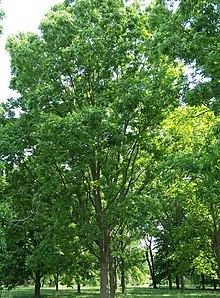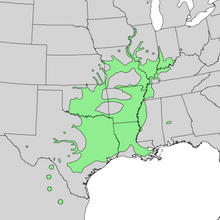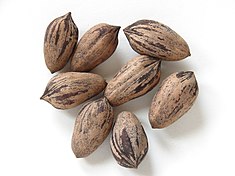Pecans
| Pecan | |
|---|---|
 |
|
|
Carya illinoinensis Morton Arboretum acc. 1082-39*3 |
|
| Scientific classification | |
| Kingdom: | Plantae |
| (unranked): | Angiosperms |
| (unranked): | Eudicots |
| (unranked): | Rosids |
| Order: | Fagales |
| Family: | Juglandaceae |
| Genus: | Carya |
| Species: | C. illinoinensis |
| Binomial name | |
|
Carya illinoinensis (Wangenh.) K.Koch |
|
 |
|
| Natural range of Carya illinoinensis | |
| Synonyms | |
|
|
 |
|
| Nutritional value per 100 grams | |
|---|---|
| Energy | 2,889 kJ (690 kcal) |
|
13.86
|
|
| Starch | 0.46 |
| Sugars | 3.97 |
| Dietary fiber | 9.6 |
|
71.97
|
|
| Saturated | 6.18 |
| Monounsaturated | 40.801 |
| Polyunsaturated | 21.614 |
|
9.17
|
|
| Vitamins | |
| Vitamin A equiv. |
(0%)
29 μg17 μg
|
| Vitamin A | 56 IU |
| Thiamine (B1) |
(57%)
0.66 mg |
| Riboflavin (B2) |
(11%)
0.13 mg |
| Niacin (B3) |
(8%)
1.167 mg |
| Pantothenic acid (B5) |
(17%)
0.863 mg |
| Vitamin B6 |
(16%)
0.21 mg |
| Folate (B9) |
(6%)
22 μg |
| Vitamin C |
(1%)
1.1 mg |
| Vitamin D |
(0%)
0 μg |
| Vitamin E |
(9%)
1.4 mg |
| Vitamin K |
(3%)
3.5 μg |
| Minerals | |
| Calcium |
(7%)
70 mg |
| Iron |
(19%)
2.53 mg |
| Magnesium |
(34%)
121 mg |
| Manganese |
(214%)
4.5 mg |
| Phosphorus |
(40%)
277 mg |
| Potassium |
(9%)
410 mg |
| Sodium |
(0%)
0 mg |
| Zinc |
(48%)
4.53 mg |
| Other constituents | |
| Water | 3.52 |
|
|
|
|
|
| Percentages are roughly approximated using US recommendations for adults. Source: USDA Nutrient Database |
|
The pecan (Carya illinoinensis) is a species of hickory native to Mexico and the southcentral and southeastern regions of the United States.
"Pecan" is from an Algonquian word variously referring to pecans, walnuts and hickory nuts, or more broadly to any nut requiring a stone to crack. There are many variant pronunciations, some regional and others not. The most common American pronunciation is /piˈkɑːn/; the most common British one is /pɪˈkæn/. Unusually, there is little agreement in the United States, even regionally, as to the "correct" pronunciation.
The pecan tree is a large deciduous tree, growing to 20–40 m (66–131 ft) in height, rarely to 44 m (144 ft). It typically has a spread of 12–23 m (39–75 ft) with a trunk up to 2 m (6.6 ft) diameter. A 10-year-old sapling will stand about 5 m (16 ft) tall. The leaves are alternate, 30–45 cm (12–18 in) long, and pinnate with 9–17 leaflets, each leaflet 5–12 cm (2.0–4.7 in) long and 2–6 cm (0.79–2.36 in) broad.
...
Wikipedia
